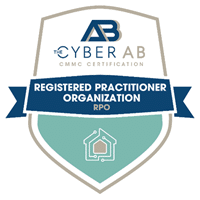Small Business Cybersecurity
In today’s digital age, information has become one of the most valuable assets for businesses. The vast amount of data generated and stored electronically presents unprecedented opportunities and at the same time, significant challenges. Information is the lifeblood of organizations, enabling informed decision-making, enhancing customer experiences, and driving innovation. However, this abundance of information also attracts threats, making cybersecurity and risk management essential to the long-term success of your business.
With data stored in the cloud, meetings held virtually, and full networks connected to the internet, companies are faced with new threats that many organizations are still learning to deal with. Cybersecurity measures aren’t always in place when they need to be, and ransomware, phishing emails, and increasingly sophisticated hackers pose new challenges to companies. If you think your business is too small for bad actors to be interested in, think again.

Forty-three percent of Cyber-Attacks Target Small Business
According to an article published by Northcentral University’s Insights and Stories blog, nearly 43 percent of cyber-attacks target small businesses. Of those small businesses facing cyber-attacks, 60 percent of them can’t afford the cost of the damage and end up closing their doors. Knowing how to manage the risk posed to your information systems can help you stay ahead of these aggressive threats. Interestingly, and to your benefit, most breaches of information are caused by shortfalls in protection, not by new hacker practices.
Cybersecurity Predictions
The international research and advisory firm, Gartner, Inc. predicts that “by 2025, lack of talent or human failure will be responsible for over half of significant cyber incidents. The number of cyber and social engineering attacks against people is spiking as threat actors increasingly see humans as the most vulnerable point of exploitation.” Gartner also predicts that “spending on information security and risk management products and services is forecast to grow 11.3% to reach more than $188.3 billion in 2023.”
What is Cybersecurity?
Cybersecurity refers to the practice of safeguarding digital systems, networks, and data from theft, damage, or unauthorized access. It incorporates a wide array of techniques, processes, and cyber hygiene practices designed to protect computers, servers, mobile devices, electronic systems, networks, and data from cyber-attacks.
What is a Cyber Attack?
In our interconnected world, the term “cyber-attack” has become all too familiar, striking fear in individuals, businesses, and even entire countries. But what exactly is a cyber-attack? At this point, not only are we not prepared to protect ourselves from major cyber incidents, but most people are in a state of denial about how critical the situation is. We need to prepare with education, get some national and international laws nailed down, get cyber certified, and take individual responsibility for our cyber security.

Understanding Cyber Attacks
A cyber-attack refers to a malicious attempt by individuals, groups, or countries to breach digital systems, networks, or devices with the intent to steal, alter, or destroy sensitive data, disrupt operations, or gain unauthorized access. These attacks can target a wide array of entities, including individuals, businesses, government agencies, and critical infrastructure.
Types of Cyber Attacks
Malware Attacks
Malicious software, commonly known as malware, includes viruses, worms, and ransomware. These programs are designed to infiltrate systems, corrupt data, and demand ransoms for their release.
Phishing Attacks
Phishing attacks involve deceptive emails, messages, or websites that impersonate legitimate sources to trick users into revealing sensitive information such as passwords or credit card numbers.
Distributed Denial of Service (DDoS) Attacks
DDoS attacks overwhelm a target system with a flood of traffic, rendering it inaccessible to users. This disruption can have severe consequences, particularly for online businesses.
Man-in-the-Middle Attacks
In these attacks, a third party intercepts communication between two parties, allowing the attacker to eavesdrop, steal data, or inject malicious content into the exchange.
SQL Injection
SQL injection attacks target databases by inserting malicious code into SQL statements, enabling attackers to manipulate or access the database, and potentially gaining unauthorized control.
Zero-Day Exploits
Zero-day exploits target unknown vulnerabilities in software or hardware before developers can create patches, making them particularly dangerous as there is no defense against them at the time of the attack.
Components of Cybersecurity
Network Security
This involves securing networks from unauthorized access, attacks, and intrusions. Firewalls, VPNs (Virtual Private Networks), and intrusion detection systems are key components of network security.
Information Security
Information security focuses on protecting data from unauthorized access, alteration, disclosure, or destruction. Encryption, access control, and data masking are employed to ensure information security.

Application Security
Application security involves safeguarding software applications from threats and vulnerabilities. Secure coding practices and regular software updates are essential for application security.
Endpoint Security
Endpoint devices, such as computers, smartphones, and tablets, are all vulnerable to attacks. Endpoint security solutions like antivirus software and endpoint detection and response (EDR) tools protect these devices from malware and other threats.
Consequences of Cyber Attacks
Data Breaches
Cyber-attacks can lead to massive data breaches, exposing sensitive information such as personal records, financial data, and intellectual property. This can result in identity theft, financial losses, and reputational damage.
Financial Losses
Businesses often suffer significant financial losses due to downtime, legal fees, and costs associated with restoring compromised systems and customer trust.
Reputational Damage
Organizations hit by cyber-attacks can experience a loss of trust among customers, partners, and stakeholders, damaging their reputation and potentially leading to long-term repercussions.
National Security Threats
Nation-states engaged in cyber warfare can target critical infrastructure, government systems, and military networks, posing a direct threat to national security.
Human-Centric Cybersecurity
When it comes to cybersecurity, proactive actions like engaging employees and training your workforce work the best. This is because most of the successful cyber-attacks involve human beings. Practicing tight information management and stringent security processes creates a successful environment for minimizing the risks of cyber-attacks. By educating employees about these tactics and raising awareness about the potential risks, organizations can empower their workforce to recognize and respond effectively to such threats.

Why is Cybersecurity Important?
Protection Against Threats
Cybersecurity shields us against a wide range of threats, including viruses, malware, ransomware, and phishing attacks. These malicious entities can compromise sensitive information, disrupt operations, and cause financial losses.
Data Privacy
With the proliferation of online platforms, protecting personal and sensitive data is paramount. Cybersecurity measures ensure that private information remains confidential and is not exploited by malicious actors.
Preserving Trust
Cybersecurity fosters trust among users, encouraging them to engage in online activities without fear of data breaches or identity theft. Trust is the bedrock of the digital economy and society.
Cybersecurity Best Practices
Regular Software Updates
Keeping operating systems, applications, and antivirus programs up to date is fundamental to patching vulnerabilities and protecting against known threats.
Strong Authentication
Implementing strong, multi-factor authentication adds an extra layer of security, ensuring that even if passwords are compromised, unauthorized access is difficult.
User Education
Educating users about cybersecurity risks, safe browsing habits, and recognizing phishing attempts empowers them to be vigilant and cautious online.
Incident Response Plan
Having a well-defined incident response plan in place enables organizations to effectively respond to and mitigate the impact of cyberattacks when they occur.
Turn your IT Group into Cybersecurity Educators

Set up a Cybersecurity Management System
As we carefully examine best practices and programs to safeguard your company’s information, it’s essential to equip your entire team, not just your IT department, with the skills to manage the increased responsibilities of a connected business environment.
Continuous Monitoring and Access
It’s nearly guaranteed that your team will be using mobile, tablet, and other smart tools to complete their work efficiently and with ease, wherever they are.
Conducting vulnerability assessments and requiring safeguards to be implemented and followed on all devices used by your team will take time, patience, and a lot of encouragement. While your IT team will drive the process, the engagement of your workforce is what will make this strategy for information and cybersecurity impactful for your business.
Training and Thought Leadership
Help Desk and Connectivity Support

You Need More than IT when It Comes to Cybersecurity
Protecting your company, employees, customers, and stockholders against cybersecurity threats requires much more than what an IT individual, team, or department can accomplish.
Think of all the information you have stored in a cloud or network-based system. From financial information to intellectual property, employee details, and even information entrusted to you by third-party partners.
Owners of small businesses commonly assume that they are too small to be targeted for cyber-attacks. The size of your business doesn’t protect you from attacks and it certainly won’t protect you from the fallout if your information is compromised. A cyber-attack could destroy your business and your reputation.
Cybersecurity Compliance and Certification
One significant way companies are making investments in their information and cybersecurity is by following the process to become certified against standards set forth by organizations like ISO.
ISO 27001
Like the other ISO standards, the ISO 27001 requirements help keep information assets secure through an information security management system (ISMS). The system requires a full assessment of your existing information and cybersecurity system, the development of new processes and procedures to protect against attacks, rigid documentation and records of your practices, and an audit by a third party to ensure compliance.
CMMC
CMMC measures cybersecurity at 3 levels, from Foundational to Expert. Businesses that only handle Federal Contract Information (FCI) will require Level 1. Businesses that handle Controlled Unclassified Information (CUI) will require Level 2. Level 3 exists to protect highly sensitive CUI and will be required by a few contractors.
See this webinar about the difference between FCI and CUI.
NIST Compliance
NIST Compliance is demonstrated with the use of a self-assessment against the 110 requirements outlined in NIST 800-171. Every one of the NIST controls has a weighted value associated with it. It’s either one point, three points, or five points. You could have at best, a positive score of 110 or at worst, a negative 203. Scores must be submitted before contracts or renewals are awarded. Scores are registered in the DoD’s Supplier Performance Risk System (SPRS).
Cybersecurity and Risk Management
In tandem with cybersecurity, risk management plays a crucial role in safeguarding valuable information. Risk management involves identifying, assessing, and prioritizing risks to minimize their impact on an organization’s objectives. By understanding potential cybersecurity risks, businesses can proactively implement preventive measures and develop contingency plans. Regular risk assessments and vulnerability analyses are essential components of a comprehensive risk management strategy.

By integrating cybersecurity best practices into risk management frameworks, businesses can navigate the digital landscape securely, ensuring the confidentiality, integrity, and availability of their information assets.
Continuous Improvement
It’s good business practice to constantly monitor your systems and to consistently work to improve whenever and wherever necessary. This is true for both information and cybersecurity. Keep a steady eye on your systems and operational protocols and make notes when a potential threat appears. If you identify weak points, address them promptly.
Your entire team likely works with your network in some way. Encourage open communication for any member of your team to come forward with ideas of how to keep the information they work with safe.
Proactive Preparation
Achieving ISO certification for information and cybersecurity systems not only sets you up for the highest level of protection against threats, but also shows proof to your customers, employees, and shareholders that you take the protection of your information, and theirs, very seriously.
Information and cybersecurity are so much more than password protection and IT monitoring. It requires a combination of quality checks, constant vulnerability assessments, physical protection measures, and, most importantly, teamwork. Set requirements that safeguard your information and be diligent in your follow-through. Collectively, you can prepare for any threat that may emerge in cyberspace.
Contact us if you’d like to learn more about how to implement cybersecurity, CMMC/NIST, or ISO 27001 for your small business at 866.354.0300.
Our Solution
We offer a simple, effective solution to help small businesses meet their cybersecurity needs:
CORE Vault™
Everything you need for NIST/CMMC in one cloud-based solution
CORE Vault comes ready-made for compliance with the DoD contracting requirements of DFARS, NIST SP 800-171, and CMMC 2.0. With CORE Vault™, you can separate government data from your network and access it through a secure, cloud-based environment managed by our cyber experts. CORE Vault™ also includes the support needed to reach full compliance with the non-technical cybersecurity requirements, such as your system security plan and required policies.
Core Business Solutions, established in 2000, is a Registered Practitioner Organization through the Cyber AB and has been providing consulting and technical solutions for NIST/CMMC for over 5 years. Rick Krick is the Director of Security Solutions for Core Business Solutions and directs our Cybersecurity Services solutions including CMMC. Rick has over 25 years of experience in Management System implementations, software development, IT services, and certifications.




